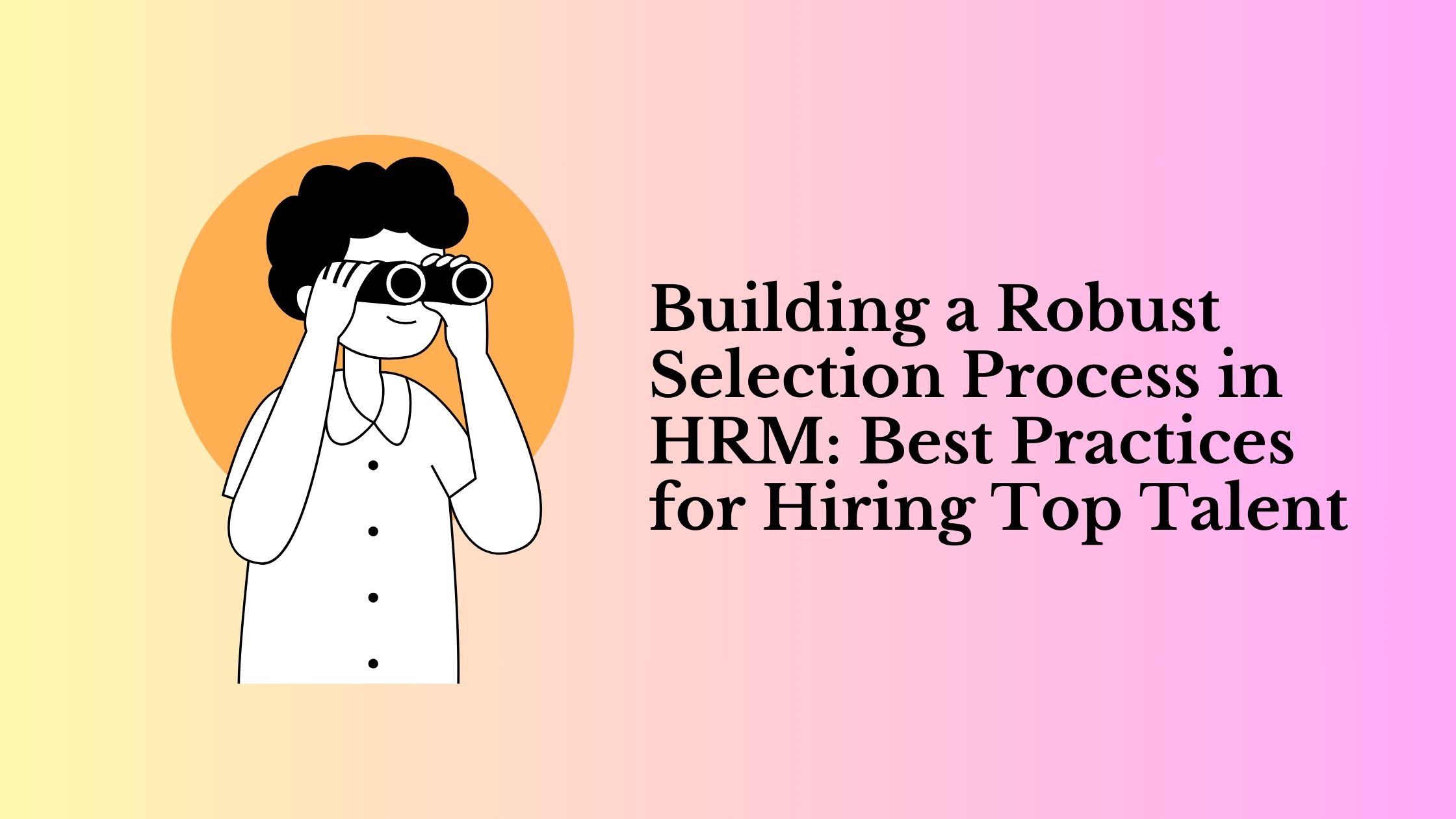A well-crafted selection process is the linchpin of effective talent acquisition and successful performance management within any organization. In this comprehensive guide, we will delve into the intricacies of the selection process, unraveling the seven key stages that constitute a successful candidate journey. By understanding and implementing best practices at each stage, organizations can not only identify the most suitable candidates but also ensure a positive and inclusive candidate experience.
What is the purpose of conducting employment interviews?
The primary objective of conducting employment interviews is to comprehensively assess a candidate’s skill set and evaluate their capability to contribute effectively within an organizational context. The purpose extends to gauging the candidate’s suitability for a particular role and providing them with a detailed understanding of the job profile and expectations. Additionally, employment interviews play a crucial role in the selection process, aiming to identify individuals whose qualifications and attributes align seamlessly with the requirements of the job, ensuring a strategic match between the candidate and the organizational needs.
Who is in charge of the selection process?
The responsibility for the hiring process varies across organizations. In certain companies, the HR department takes charge of hiring, while others rely on a talent search committee to select candidates for interviews and make hiring decisions. In smaller businesses, the hiring manager may also serve as the supervisor for the new hire.
Importance of selection process in HRM
The selection process holds paramount importance as it directly impacts an organization’s overall performance by influencing the quality of hired resources. Poor hiring practices can detrimentally affect ongoing work, leading to high replacement costs. The primary objective of the selection process is to pinpoint the most qualified candidates for available positions within the company, considering factors like qualifications, experiences, skills, and overall attitude.
This significance is underscored by several critical aspects:
- Business Success and Employee Quality: The success of a business is intricately linked to the caliber of its employees and their capacity to contribute effectively. The quality of employees fundamentally shapes the company’s performance.
- Acceleration of Business Growth: Employees possessing high levels of talent and expertise play a pivotal role in expediting the growth trajectory of the business, contributing to its overall success.
- Safety in Technical Jobs: In technical roles, the risk of workplace accidents can be significantly diminished by ensuring that the right technical personnel is appointed to the appropriate positions, emphasizing the importance of precision in the selection process.
- Employee Satisfaction and Motivation: Individuals content with their roles are more likely to exhibit high morale and motivation, fostering a conducive environment for success and productivity within the organization.
- Investment in Recruitment: Given the substantial financial investment in finding the right candidate, organizations must adopt a systematic approach to the HR selection process. In instances of faulty hires, the company is compelled to allocate substantial time, effort, and financial resources to train and integrate the new employee.
In essence, the selection process stands as a critical determinant of organizational success, necessitating a meticulous and strategic approach to ensure the acquisition of the right talent for sustained growth and effectiveness.
The Selection Process Funnel
The recruitment and selection process can be visualized as a funnel, beginning with a job opening and narrowing down to the final selection and job offer. Each stage plays a crucial role in filtering and assessing candidates, allowing organizations to make informed decisions. Let’s explore the seven stages in detail:
- Application:
The journey commences with the creation and posting of a job opening. The quality and diversity of applicants can be influenced by both external and internal factors. A carefully crafted job advert, utilizing gender-neutral language and considering the necessity of higher education, can attract a pool of qualified candidates. Additionally, optimizing the application process for mobile use ensures a seamless experience for applicants.
Channels and tools for posting job ads, such as online job boards, company websites, recruitment agencies, and word of mouth, significantly impact the reach and diversity of applicants. Leveraging tools like Textio, which uses AI to optimize job adverts for inclusivity, can enhance the quality and quantity of applications.
- Screening & Pre-selection:
The screening and pre-selection stage is designed to narrow down the candidate pool to a manageable size for interviews. Techniques include resume screening, phone screenings, and pre-employment assessments. While technology, like AI-powered resume screeners and chatbots, can streamline this process, caution must be exercised to avoid bias.
Pre-selection tools, encompassing cognitive testing, job simulations, and other assessments, play a vital role in identifying the most suitable candidates, particularly in high-volume recruitment scenarios. Striking a balance between efficiency and accuracy is essential when implementing these tools.
- Interview:
The interview stage is perhaps the most visible and well-known step in the selection process. Interviews, whether conducted virtually or in person, provide insights into a candidate’s verbal fluency, sociability, and suitability for the role. Structured interviews with standardized questions and the STAR method (Situation, Task, Action, Result) enhance the reliability of the evaluation.
Different interview types, including peer interviews and panel interviews, offer diverse perspectives on a candidate’s personality and compatibility with the team. The use of interview guides contributes to fairness and consistency in the selection process.
- Assessment:
Building on the pre-selection assessments, the full assessment stage involves more detailed evaluations, such as General Mental Ability (GMA) tests and personality assessments. These assessments aim to predict a candidate’s job performance accurately. Work sample tests, integrity tests, and job knowledge tests offer a holistic view of a candidate’s capabilities.
Quality of hire is a critical metric associated with this stage, measuring the performance of new hires after a year on the job. Implementing assessments aligned with key job competencies ensures a robust evaluation process.
- References and Background Check:
Reference checks and background checks serve as a crucial step to validate information provided by candidates and gain additional insights. Reference checks, based on candidate-provided references, offer a different perspective on a candidate’s competencies. Background checks, including criminal record checks, are essential for roles involving high responsibility.
Conducting background checks as late in the selection process as possible, in compliance with legal requirements, ensures thorough vetting without unnecessary delays.
- Decision:
The decision-making stage involves choosing the candidate with the greatest potential for the organization. A data-driven approach, with predefined criteria for rating candidates, enhances fairness and transparency. Involving multiple stakeholders, including hiring managers and colleagues, ensures a comprehensive decision-making process.
Balancing the trade-off between immediate qualifications and long-term commitment is crucial when making hiring decisions. The final decision should align with the organization’s strategic goals and values.
- Job Offer & Contract:
The culmination of the selection process is the job offer and contract stage. The selected candidate is presented with an offer, and upon acceptance, a formal employment contract is drawn up and signed. This stage requires effective communication and a clear understanding of the terms to ensure a smooth transition from candidate to employee.
Metrics in the Selection Process:
Monitoring key metrics throughout the selection process provides insights into the effectiveness of an organization’s talent acquisition efforts. Metrics such as time to fill, 90-day attrition, first-year attrition, candidate experience, and selection process funnel effectiveness offer valuable data for continuous improvement.
Conclusion:
A robust selection process is foundational to an organization’s long-term success. By implementing best practices at each stage of the candidate journey, HR professionals can contribute significantly to building a competitive advantage for their organizations. Prioritizing inclusivity, leveraging technology judiciously, and measuring key metrics ensure that the selection process aligns with organizational goals and fosters the recruitment of top-tier talent.

Darren Trumbler is a versatile content writer specializing in B2B technology, marketing strategies, and wellness. With a knack for breaking down complex topics into engaging, easy-to-understand narratives, Darren helps businesses communicate effectively with their audiences.
Over the years, Darren has crafted high-impact content for diverse industries, from tech startups to established enterprises, focusing on thought leadership articles, blog posts, and marketing collateral that drive results. Beyond his professional expertise, he is passionate about wellness and enjoys writing about strategies for achieving balance in work and life.
When he’s not creating compelling content, Darren can be found exploring the latest tech innovations, reading up on marketing trends, or advocating for a healthier lifestyle.
